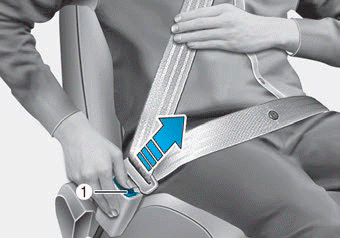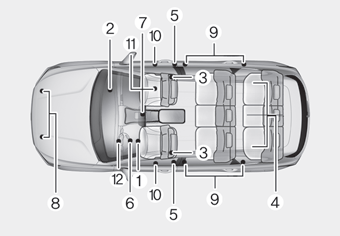Hyundai Palisade: Seat Belt Restraint System / Rear Seat Belt – Passenger's 3- point system with convertible locking retractor
This type of seat belt combines the features of both an emergency locking retractor seat belt and an automatic locking retractor seat belt. Convertible retractor type seat belts are installed in the rear seat positions to help accommodate the installation of child restraint systems. Although a convertible retractor is also installed in the front passenger seat position, NEVER place any infant/child restraint system in the front seat of the vehicle.
To fasten your seat belt:
Pull the seat belt out of the retractor and insert the metal tab into the buckle. There will be an audible "click" when the tab locks into the buckle. When not securing a child restraint, the seat belt operates in the same way as the driver's seat belt (Emergency Locking Retractor Type). It automatically adjusts to the proper length only after the lap belt portion of the seat belt is adjusted manually so that it fits snugly across your hips.
When the seat belt is fully extended from the retractor to allow the installation of a child restraint system, the seat belt operation changes to allow the belt to retract, but not to extend (Automatic Locking Retractor Type). Refer to the "Using a Child Restraint System" section in this chapter.
NOTICE
Although the seat belt retractor provides the same level of protection for seated passengers in either emergency or automatic locking modes, the emergency locking mode allows seated passengers to move freely in their seat while keeping some tension on the belt. During a collision or sudden stop, the retractor automatically locks the belt to help restrain your body.
To deactivate the automatic locking mode, unbuckle the seat belt and allow the belt to fully retract.

To release your seat belt:
Press the release button (1) in the locking buckle.
When it is released, the belt should automatically draw back into the retractor. If this does not happen, check the belt to be sure it is not twisted, then try again.
 Seat Belt-Driver's 3-point system
with emergency locking
retractor
Seat Belt-Driver's 3-point system
with emergency locking
retractor
To fasten your seat belt:
Pull the seat belt out of the retractor
and insert the metal tab (1) into the
buckle (2). There will be an audible
"click" when the tab locks into the
buckle...
 Rear center seatbelt (3rd row)
Rear center seatbelt (3rd row)
To fasten your seatbelt:
1.Extract the tongue plate (A) from
the hole on the belt assembly
cover.
2.Insert the tongue plate (A) into the
buckle (A’) until an audible “click" is
heard, indicating the latch is
locked...
Other information:
Hyundai Palisade (LX2) 2020-2025 Service Manual: Power Door Mirror Assembly
Components and components location Components 1. Blind spot radar warning indicator 2. Side repeater lamp 3. Puddle lamp 4. SVM camera Repair procedures Inspection 1. Disconnect the negative (-) battery terminal...
Hyundai Palisade (LX2) 2020-2025 Owner's Manual: Seat Belt Warning Light, Air Bag Warning Light, Parking Brake & Brake Fluid Warning Light
Seat Belt Warning Light This warning light informs the driver that the seat belt is not fastened. Air Bag Warning Light This warning light illuminates: When you set the ignition switch or the Engine Start/Stop button to the ON position. - The air bag warning light illuminates for about 6 seconds and then turns off when all checks have been performed The air bag warning light will remain illuminated if there is a malfunction with the Safety Restraint System (SRS) air bag operation...
Categories
- Manuals Home
- 1st Generation Palisade Owners Manual
- 1st Generation Palisade Service Manual
- Side view mirror adjustment, Folding the side view mirrors
- Child-Protector Rear Door Locks
- Reverse Parking Aid Function
- New on site
- Most important about car
How Does the Air Bag System Operate?

The SRS consists of the following components:
1. Driver's front air bag module
2. Passenger's front air bag module
3. Side air bag modules
4. Curtain air bag modules
5. Retractor pre-tensioner
6. Air bag warning light
7. SRS control module (SRSCM)/
Rollover sensor
8. Front impact sensors
9. Side impact sensors
10.Side pressure sensors
11. Occupant classification system
12. Driver’s knee airbag module
